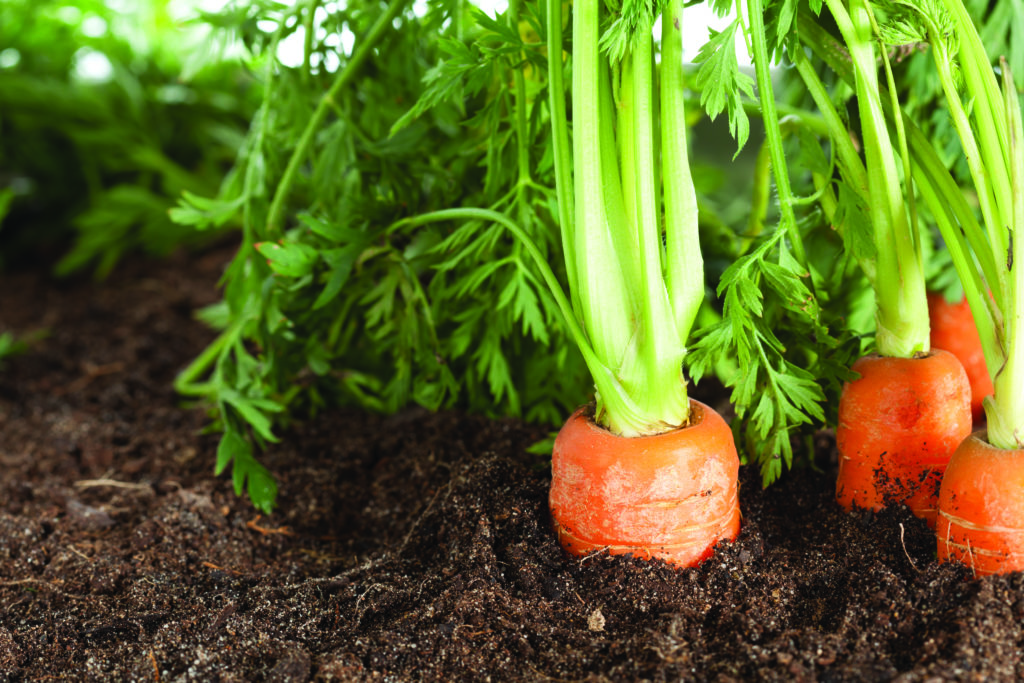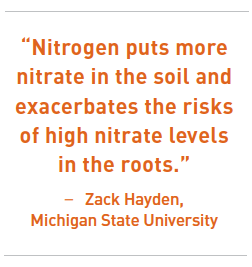

Mar 13, 2019Carrot nitrate content could soar in late season
That last nitrogen fertilizer application before carrot harvest is thought to benefit yield, strengthen tops for harvest and possibly reduce susceptibility to foliar disease. It can also increase nitrate levels in the harvested carrots with potential human health concerns and run afoul of processor rules on nitrate content.
“Growers are applying nitrogen late in the season on sandy soils with the goal of protecting yield, and maybe nitrogen fertilizer will help with disease, but more nitrogen also puts more nitrate in the soil and exacerbates the risks of high nitrate levels in the roots,” said Zack Hayden, vegetable soil and nutrient management specialist in Michigan State University’s (MSU) Department of Horticulture. Hayden was a speaker at the recent Great Lakes Fruit, Vegetable and Farm Market EXPO in Grand Rapids, Michigan.
The situation is complex. The timing of that last nitrogen application, the presence and severity of foliar disease and the type of nitrogen fertilizer used all come into play. Environmental conditions add another variable since temperature, moisture and overall growing conditions can limit – or increase –nitrogen uptake and metabolism.


Photo: Dean Peterson
“This all leads to the complexity of nitrate accumulation risks,” Hayden said.
A recent MSU study looked at the issue in processing carrots, which are often grown for baby food.
The on-farm research looked at how late-season, nitrogen applications affected carrot yield, shoot growth and root nitrate accumulation. It also evaluated how foliar disease severity affected root nitrate levels. The two-year study took place in 2017 and 2018.
In both years, urea top-dress applications in September of 30 pounds to 90 pounds of actual nitrogen per acre produced somewhat larger shoots, but no significant effects on root yield or quality.
“We did not see an increase in yield with increased, late-season nitrogen rates,” Hayden said. “Nitrogen applications in September have the potential to increase shoot size, but otherwise we saw little benefit – as long as all other management practices are sound.”
Shoot size can be related to mechanical harvest efficiency.
The plots in MSU’s trials already had a total of about 80 pounds of actual nitrogen applied per acre before the September application. This came from applications of about 20 pounds of nitrogen at planting in the spring, followed by about another 30 pounds top-dressed in July and another 30 top-dressed in August. These applications are vital since adequate, full-season, nitrogen fertility following MSU’s recommended rates remains essential for optimizing carrot yield and quality, Hayden said.


“Generally, you’re going to see that nitrate peak three to four weeks after application, but then it will go down,” Hayden said. Moving a late-season nitrogen application up a little earlier or harvesting a little later will both reduce root nitrate risk at harvest. Foliar disease inhibits top growth in carrots and increases the risk of higher nitrate accumulation in the roots later in the season. MSU’s study also evaluated the effects of low, medium and high levels of foliar disease on root nitrate levels and determined that disease pressure significantly increases root nitrate risk.
“All of these nitrate levels were not at the threshold for concern, but in a year of higher disease pressure there’s more risk of increased nitrate accumulation in the roots,” Hayden said. “If it’s a high disease situation, and you go in and apply nitrogen late in the season trying to address that, you’re likely to increase the nitrate level in the roots.”
The study also evaluated the potential for two alternative nitrogen fertilizer sources to reduce nitrate risks. In both 2017 and 2018, a late-season, foliar nitrogen application had lower levels of root nitrate than a standard, urea top-dress application.
“The goal here was to get the nitrogen into the shoot and not the roots,” Hayden said.
Soil-applied nitrogen applied in a slow-release formulation also had lower levels of root nitrate in both years. However, these lower levels of root nitrate are most likely due to lower nitrogen availability or lower plant uptake, and not currently recommended as cost-effective alternatives to urea top-dress applications.
Sound nitrogen management is important when growing a long duration crop like carrots on sandy soils. Production goals must be balanced with the risks of excessive nitrates at harvest.
“It’s important to apply the recommended rates of nitrogen and spread the applications out,” Hayden said. “In the late season, that last topdress application in September – close to harvest – is the one to be more concerned about.”
– Dean Peterson, VGN Correspondent














